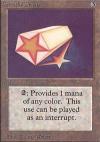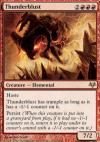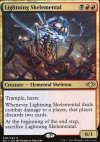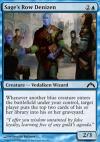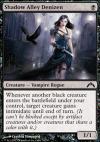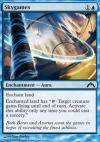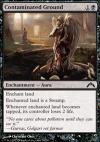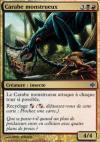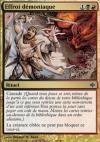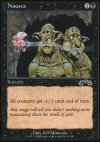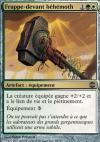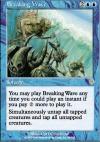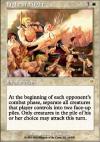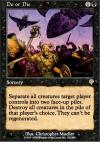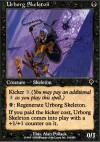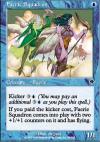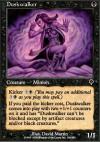|

MV anecdotes
| 4887 anecdotes trouvées |   |
Le personnage représenté sur la carte Feather, the Redeemed a un autre nom moins connu : Pierakor az Vinrenn D'rav. Ce nom est inspiré du mot slovaque "pierko", signifiant "plume".
Source
Source
Les cartes Cruel Celebrant et Cartel Aristocrat représentent le même personnage, qui a dû recevoir une promotion dans la guilde Orzhov et évoluer en vampire.
La carte Farewell est une version revisitée - et possiblement améliorée - de Merciless Eviction, la gestion des planeswalkers étant remplacée par celle des cimetières.
L'illustration de la carte Mercurial Chemister nous montre un mage en train d'utiliser ses pouvoirs afin de donner naissance à une orbe particulière. Cette orbe, qui d'un premier abord a l'air inoffensive, est en réalité l'orbe responsable d'extinction massive que l'on découvre avec la carte Merciless Eviction.
Cette malheureuse et inconsciente action est également décrite dans son texte d'ambiance, lequel nous indique que le mage conçoit l'inconcevable avec un air très détaché !
Cette malheureuse et inconsciente action est également décrite dans son texte d'ambiance, lequel nous indique que le mage conçoit l'inconcevable avec un air très détaché !
La carte Thunderblust est une référence à Ball Lightning de par son nom, son type de créature, ses force et endurance, son coût de mana dont trois colorés et ses capacités (après déclenchement de la capacité Persistance).
La carte Lightning Skelemental est une référence à Ball Lightning de par son nom, son type de créature, ses force et endurance, son coût de trois manas colorés et ses capacités (le mana noir dans son coût rajoutant de la défausse).
La carte Spark Trooper est une référence à Ball Lightning de par son type de créature, ses force et endurance, son coût de mana proche et ses capacités (le mana blanc dans son coût rajoutant le lien de vie).
Les cinq cartes Court Street Denizen, Sage's Row Denizen, Shadow Alley Denizen, Foundry Street Denizen et Ivy Lane Denizen, de l'édition Gatecrash, forment un cycle appelé "Denizen".
Les cinq cartes Debtor's Pulpit, Skygames, Contaminated Ground, Tin Street Market et Verdant Haven, de l'édition Gatecrash, forment un cycle.
Les cinq cartes Glassdust Hulk, Architects of Will, Monstrous Carabid, Deadshot Minotaur et Sigil of the Nayan Gods, de l'édition Alara Reborn, forment un cycle de sorts bicolores communs avec une capacité de Recyclage pour un coût de un mana hybride correspondant à leurs deux couleurs.
Source (Alara Reborn - "There was also a common cycle that had cycling using a single hybrid mana. The idea was that you would play it in a deck with both colors, but if you don't draw one of them, you can cycle the card away.")
Source (Alara Reborn - "There was also a common cycle that had cycling using a single hybrid mana. The idea was that you would play it in a deck with both colors, but if you don't draw one of them, you can cycle the card away.")
Les cinq cartes Sanctum Plowbeast, Jhessian Zombies, Igneous Pouncer, Valley Rannet et Pale Recluse, de l'édition Alara Reborn, forment un cycle de créatures bicolores avec la capacité Recyclage d'un type de terrain de base des deux types de terrain correspondant à leurs deux couleurs.
Les cinq cartes Stormcaller's Boon, Deny Reality, Demonic Dread, Violent Outburst et Captured Sunlight, de l'édition Alara Reborn, forment un cycle de sorts non-créature bicolores communs associés aux couleurs alliées, possédant tous la capacité Cascade.
La carte Nemesis Mask est une référence à Lure de par sa valeur de mana et son effet, il s'agit simplement de la version équipement de l'aura.
La carte Behemoth Sledge est une référence à Armadillo Cloak de par son coût de mana et son effet, il s'agit simplement de la version équipement de l'aura.
La carte Unflinching Courage en est quant à elle une réimpression fonctionnelle, à la formulation près.
La carte Unflinching Courage en est quant à elle une réimpression fonctionnelle, à la formulation près.
Sur la carte Ghitu Fire, c'est Jhoira of the Ghitu qui lance la boule de feu. Outre son appartenance aux Guitûks, elle est facilement reconnaissable grâce à ses cheveux rouges et à sa spalière à losanges, une pièce d'armure protégeant son épaule gauche.
Les cinq cartes Rout, Breaking Wave, Twilight's Call, Ghitu Fire et Saproling Symbiosis, de l'édition Invasion, forment un cycle.
Source ("I remembered back to a cycle of sorceries we'd made in Invasion [...]")
Source ("I remembered back to a cycle of sorceries we'd made in Invasion [...]")
Les cinq cartes Alabaster Leech, Sapphire Leech, Andradite Leech, Ruby Leech et Jade Leech, de l'édition Invasion, forment un cycle appelé "Leech". De plus leurs textes d'ambiance se font écho.
Ces créatures présentent une capacité commune rendant les sorts que vous lancez de la même couleur que la sangsue un mana de cette couleur plus cher. À l'époque, ce défaut était supposé contrebalancer le coût de mana alors réduit des sangsues.
Ces créatures présentent une capacité commune rendant les sorts que vous lancez de la même couleur que la sangsue un mana de cette couleur plus cher. À l'époque, ce défaut était supposé contrebalancer le coût de mana alors réduit des sangsues.
Les cinq cartes Ardent Soldier, Vodalian Serpent, Urborg Skeleton, Kavu Aggressor et Pincer Spider, de l'édition Invasion, forment un cycle de créatures communes pouvant être "kickées" avec du mana incolore afin de gagner un ou plusieurs marqueurs +1/+1.
Les deux cartes Phyrexian Reaper et Phyrexian Slayer, de l'édition Invasion et illustrées par Sam Wood, forment une paire disposant de la même capacité déclenchée à l'égard des créatures des couleurs ennemies que sont respectivement le vert et le blanc.
| 4887 anecdotes trouvées |   |






 Avatar: the Last Airbender
Avatar: the Last Airbender Spider-Man / Omenpaths
Spider-Man / Omenpaths Edge of Eternities
Edge of Eternities Final Fantasy
Final Fantasy Tarkir: Dragonstorm
Tarkir: Dragonstorm Aetherdrift
Aetherdrift Foundations
Foundations

